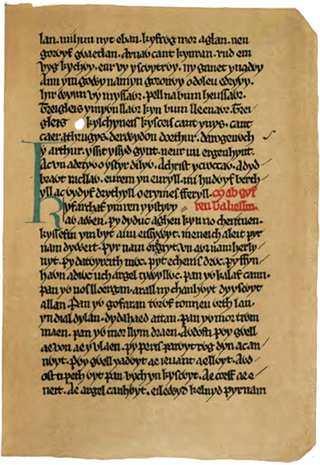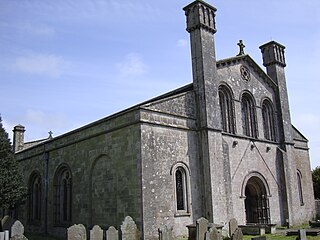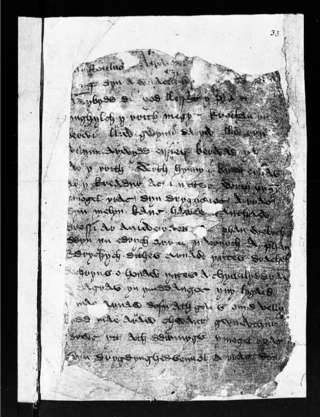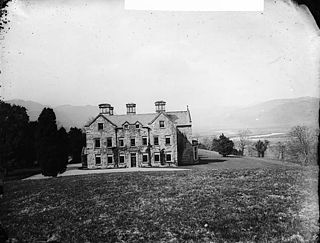Related Research Articles

The National Library of Wales, in Aberystwyth, is the national legal deposit library of Wales and is one of the Welsh Government sponsored bodies. It is the biggest library in Wales, holding over 6.5 million books and periodicals, and the largest collections of archives, portraits, maps, and photographic images in Wales. The Library is also home to the national collection of Welsh manuscripts, the National Screen and Sound Archive of Wales, and the most comprehensive collection of paintings and topographical prints in Wales. As the primary research library and archive in Wales and one of the largest research libraries in the United Kingdom, the National Library is a member of Research Libraries UK (RLUK) and the Consortium of European Research Libraries (CERL).
The Hengwrt Chaucer manuscript is an early-15th-century manuscript of the Canterbury Tales, held in the National Library of Wales, in Aberystwyth. It is an important source for Chaucer's text, and was possibly written by someone with access to an original authorial holograph, now lost.

The White Book of Rhydderch is one of the most notable and celebrated surviving manuscripts in Welsh. Mostly written in southwest Wales in the middle of the 14th century it is the earliest collection of Welsh prose texts, though it also contains some examples of early Welsh poetry. It is now part of the collection of the National Library of Wales, having been preserved in the library at Hengwrt, near Dolgellau, Gwynedd, of the 17th century antiquary Robert Vaughan, who inherited it from the calligrapher John Jones and passed it to his descendants. The collection later passed to the newly established National Library of Wales as the Peniarth or Hengwrt-Peniarth Manuscripts.

The Black Book of Carmarthen is thought to be the earliest surviving manuscript written solely in Welsh. The book dates from the mid-13th century; its name comes from its association with the Priory of St. John the Evangelist and Teulyddog at Carmarthen, and is referred to as black due to the colour of its binding. It is currently part of the collection of the National Library of Wales, where it is catalogued as NLW Peniarth MS 1.

The Book of Taliesin is one of the most famous of Middle Welsh manuscripts, dating from the first half of the 14th century though many of the fifty-six poems it preserves are taken to originate in the 10th century or before.

Peredur son of Efrawg is one of the Three Welsh Romances associated with the Mabinogion. It tells a story roughly analogous to Chrétien de Troyes' unfinished romance Perceval, the Story of the Grail, but it contains many striking differences from that work, most notably the absence of the French poem's central object, the grail.
"The five royal tribes of Wales" and "The fifteen tribes of Gwynedd" refer to a class of genealogical lists which were compiled by Welsh bards in the mid-15th century. These non-identical lists were constructed on the premise that many of the leading Welsh families of their time could trace their descent to the "five royal tribes of Wales" or the "fifteen noble tribes of Gwynedd".

Sir John Williams, 1st Baronet, was a Welsh physician, who attended Queen Victoria and was raised to the baronetcy by her in 1894. He is remembered chiefly for his contribution to the collection of the National Library of Wales. He resided for part of his life at Plas Llanstephan, Carmarthenshire, a house he acquired by lease.
Ieuan ab Owain Glyndŵr was reputedly the illegitimate son of the last native Welsh Prince of Wales; Owain Glyndŵr. The possibility of his existence was uncovered through the work of Peter Bartrum which is currently being edited by the University of Wales Aberystwyth. Ieuan ab Owain and his descendants are detailed in Peniarth Manuscript 287 in the hand of Robert Vaughan of Hengwrt (c.1592-1667) and also in the manuscript known as Harley 1969 by Griffith Hughes (1634–1665) - the original manuscripts are kept at the National Library of Wales, Aberystwyth and the British Library respectively.
Brenhinoedd y Saeson is the medieval title of a Middle Welsh annalistic chronicle. The name means 'the kings of the English'.
Robert Powell Vaughan was an eminent Welsh antiquary and collector of manuscripts. His collection, later known as the Hengwrt–Peniarth Library from the houses in which it was successively preserved, formed the nucleus of the National Library of Wales, and is still in its care.

The White Book of Hergest was an important Welsh manuscript compiled in c. 1450. It contained many Welsh poems and prose texts and was a significant source for several antiquaries of the 17th and 18th centuries, but disappeared in the early 19th century, probably being destroyed in a fire in a London bookbinder's shop in around 1810.

Brut y Saeson is a Welsh-language chronicle running from the death of Cadwaladr ap Cadwallon in 682 to the reign of Richard II (1377–99) of England. The name means the brut or chronicle of the English.

The Peniarth Manuscripts, also known as the Hengwrt–Peniarth Manuscripts, are a collection of medieval Welsh manuscripts now held by the National Library of Wales in Aberystwyth. The collection was originally assembled by Robert Vaughan of Hengwrt, Merionethshire. During the 19th century it was held in Peniarth Mansion, Llanegryn.
Peniarth 6 is a medieval Welsh manuscript. It is part of the collection of Peniarth Manuscripts, named for Peniarth Mansion in Meirionnydd, south Gwynedd, where they were kept for many years.
Wales has produced a number of manuscripts over the centuries. Although most were written in Middle Welsh or Old Welsh, some were also written in Latin. In some of the more recent manuscripts it is not uncommon to have texts in Welsh, Latin, French and English in the same volume. However, some of the most important medieval manuscripts were written in Latin only, e.g. the Cyfraith Hywel.
Peniarth Manuscript 259B, known as Pomffred since it had previously been owned by the constable of Pontefract Castle, is a version of the Laws of Hywel Dda. Aneurin Owen assigned this manuscript the siglum Z in his Ancient laws and institutes of Wales. It is one of the Peniarth Manuscripts in the National Library of Wales. It was transcribed in the mid-sixteenth century by two hands: Richard Longford and his amanuensis, from an earlier exemplar owned by Einion ab Addain, who was serving a prison sentence in Pontefract at the time that it was copied.
Daniel Huws FLSW is the world's leading authority of the last hundred years on Welsh manuscripts, with contributions that are held to represent a significant advance on those of John Gwenogvryn Evans.

Peniarth 51 is a Welsh medieval manuscript, in the hand of the poet Gwilym Tew, written in the period 1460–1480. Although it is known that Tew wrote other manuscripts, Peniarth 51 is the only entire manuscript that can be proven to have been his work. It is kept in the National Library of Wales, Aberystwyth, as part of the Peniarth Manuscripts collection.

Hengwrt was a mansion near Dolgellau in Meirionnydd, Gwynedd. It lay in the parish of Llanelltyd near the confluence of the River Mawddach and River Wnion, near Cymer Abbey. With medieval origins, it was rebuilt or remodelled on several occasions before being demolished in 1962. It is remembered as the original home of the important collection of the Peniarth Manuscripts, now in the National Library of Wales.
References
- 1 2 Harris, Meinir Elin (2006). A bibliography of the Welsh Law Manuscripts. [Aberystwyth]: [Canolfan Uwchefrydiau Cymreig a Cheltaidd Coleg Prifysgol Cymru].
- ↑ Gwenogvryn Evans, John (1898). Report on Manuscripts in the Welsh Language. Historical Manuscripts Commission.